In the 1990s the annual meetings of ATypI (Association Typographique Internationale) were often fascinating events. The organization was in transition. Formed in 1957, as a grouping of type manufacturers, it represented the industry’s attempt to regulate itself, and especially to prevent – without recourse to the courts of law – one company from copying the designs of another.
Before the moment of PostScript (in the mid-1980s), the ATypI annual congresses had been works outings for employees of the large type manufacturing companies. They were held in historic locations, with splendid dinners, tourist bus trips for the delegates’ spouses, and a bit of culture attached – in the form of lectures about typography. But with the advent of desktop production and the integration of design and manufacturing within easily purchased and easily understood software, ATypI changed.1
In 1990, Type 9o (the name was itself a rebranding) at Oxford gave a visible start to this process. The next year, in Parma, there were ructions, as a new, younger element (represented by the British-American Mark Batty of the International Typeface Corporation [ITC] in New York) tried to depose the ruling party on the board of the organization. A couple of years later the old regime, run essentially by the German and Swiss manufacturing interests, was succeeded by Batty and ITC. Then a sign of real change came in 2004 with the appointment of the next president: Jean-François Porchez, a pure representative of the new world of the self-employed ‘young guys with laptops’.
The insurgency had come to the boil in 1993 at the meeting in Antwerp. A group of (primarily) Dutch type designers demanded something more realistic and more engaging than a set of lectures on ‘The Alphabet goes Multimedia’. (The main mover here was Petr van Blokland, joined by Neville Brody and David Berlow.) This was the birth of the TypeLab, a hands-on work session, in which people could give small-scale demonstrations, could talk about their work, and in which every day a newspaper was produced.
ATypI 1994
The TypeLab at the meeting of 1994 in SanFrancisco was the context for Fred Smeijers to give a demonstration of punchcutting. My photos of the event have recently re-emerged, and are the occasion for this reminiscence.
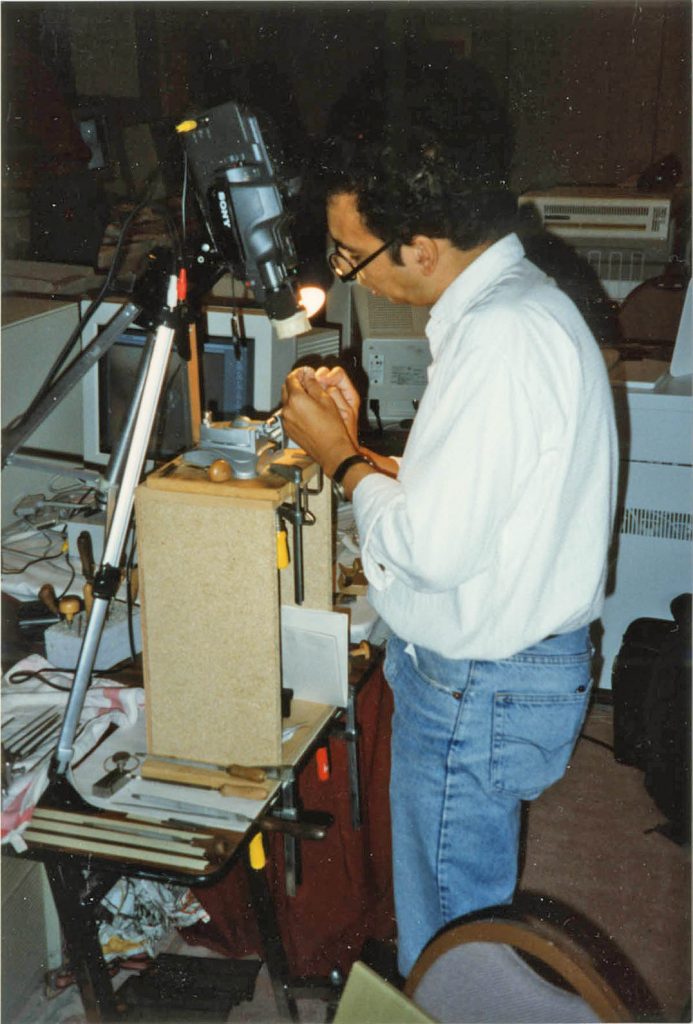
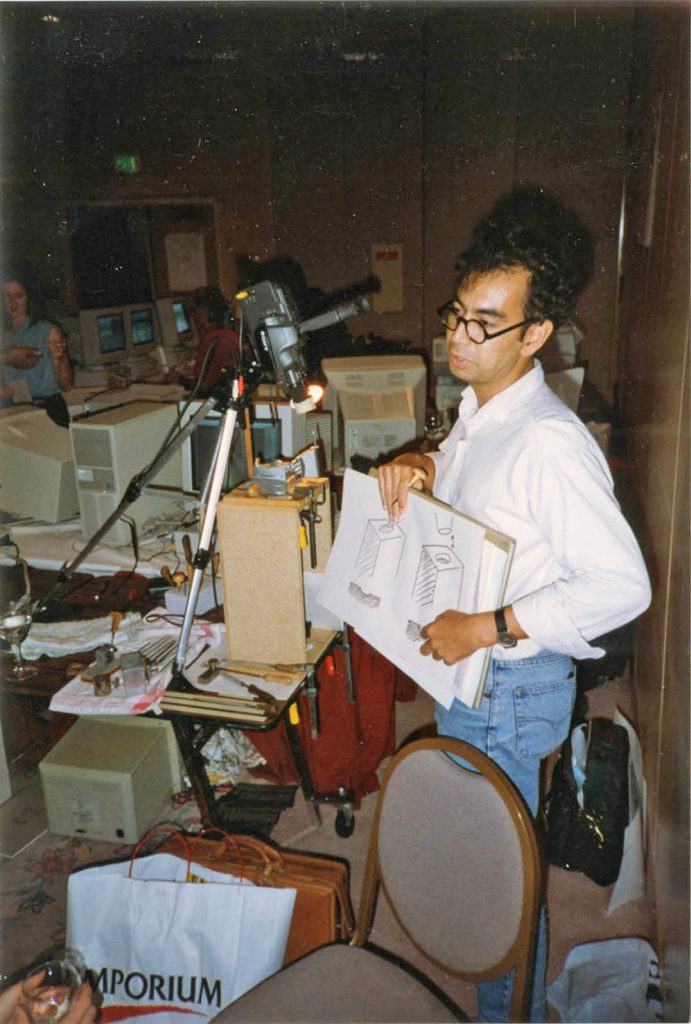
Fred, with help from his studio colleague Erik Vos, had devised a simple and effective way of showing how punches are cut, to make matrices from which type can be cast: a video camera was positioned above his work-bench, and the images were then transmitted to a monitor.
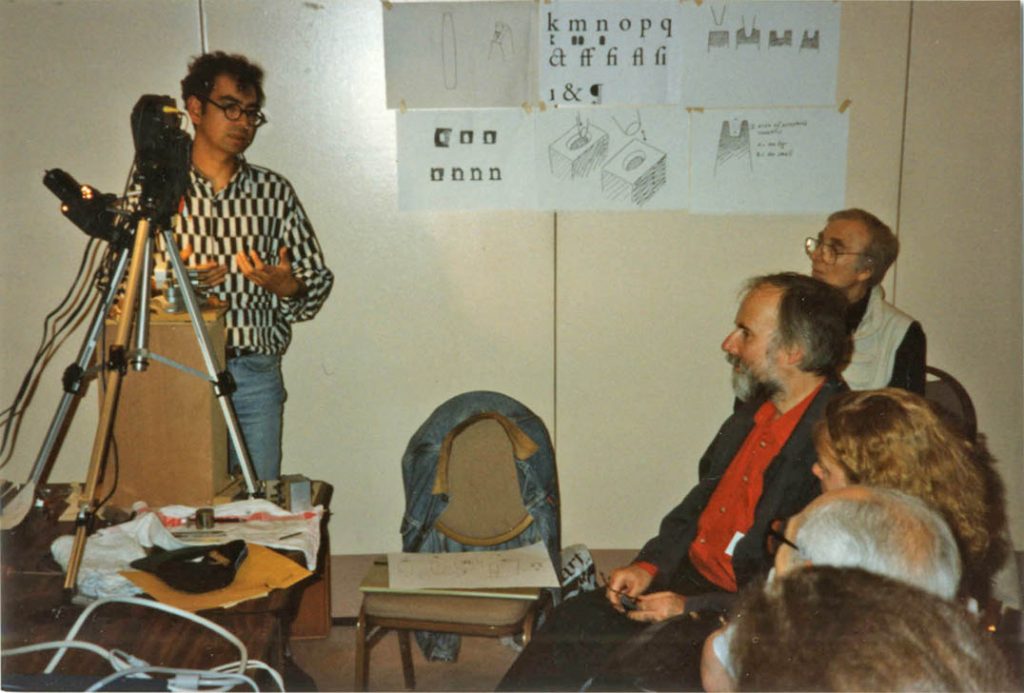
Among the audience, James Mosley (in the red shirt).
Photographs of the punchcutting process are common enough, but certainly I had never seen the work recorded on film at such magnification. I wrote a rapid report of it for the TypeLab Chronicle, in a style that borrowed something from tabloid journalism.
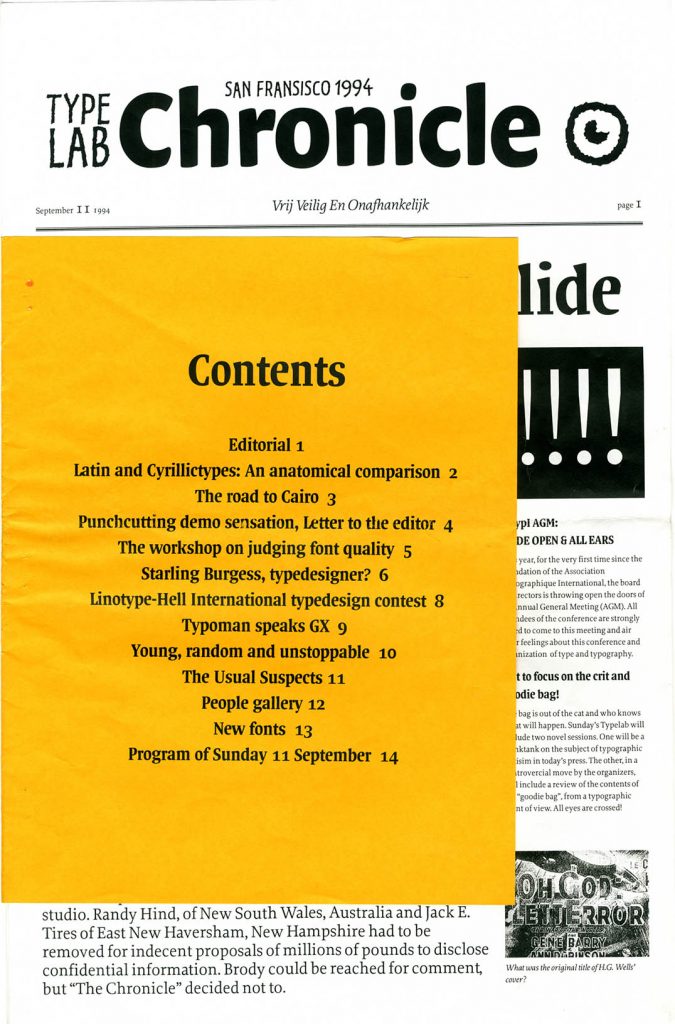
The word ‘Chronicle’ in the masthead was drawn, same-size, by Peter Matthias Noordzij.
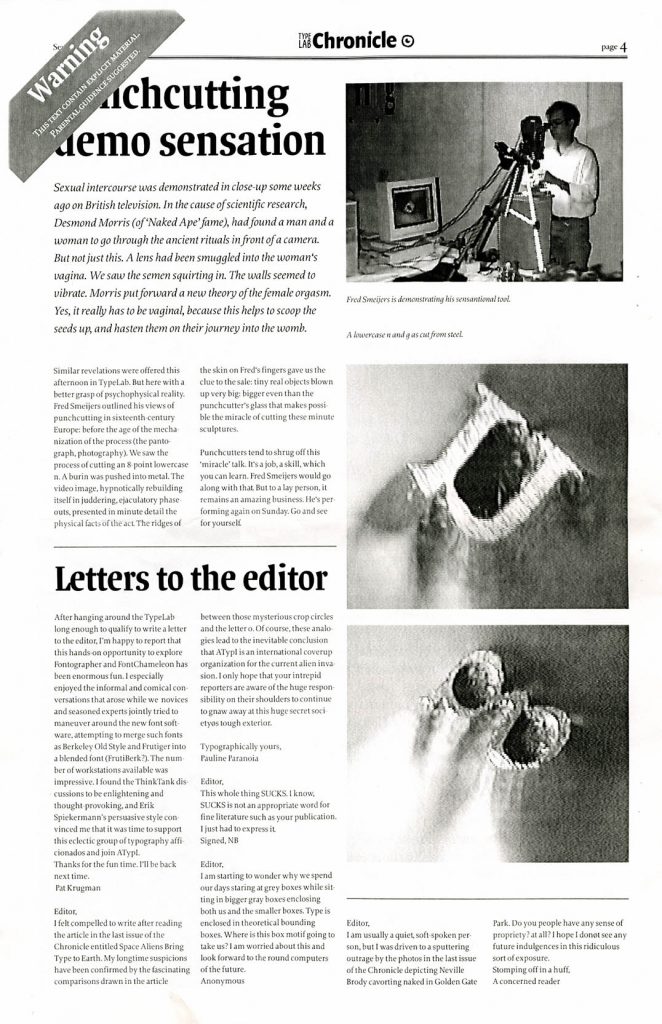
This was part of the process leading up to the publication of Fred’s book Counterpunch. And we included grabs from some of the video recordings as illustrations in the book. We had already announced Counterpunch in 1993, with a printed leaflet for the Antwerp meeting of that year. After San Francisco, another two years passed before we were able to launch the book at the ATypI meeting in The Hague, 1996. Finished copies were ready just hours before we could present it at that year’s TypeLab, with a seminar discussion that featured a number of Fred’s colleagues on the panel.
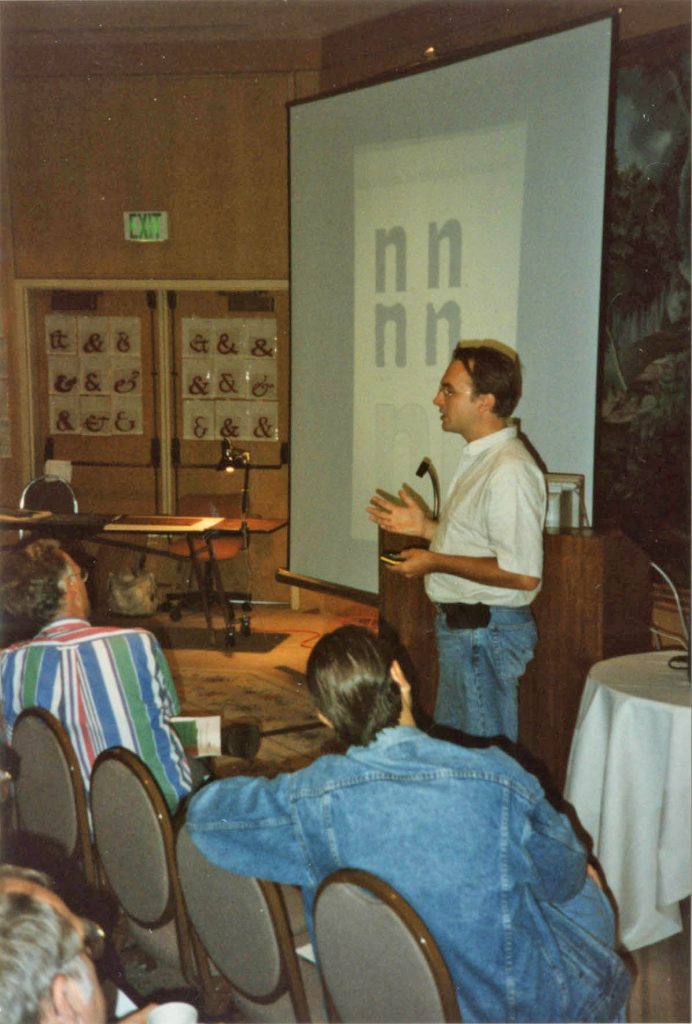
Another contribution to the San Francisco TypeLab came from Fred’s colleague and friend, Martin Majoor, who spoke about his work on the new design for the Dutch telephone book, which he had started in 1993 and which was finished that year, 1994.
ATypI 2018
Last month, twenty-five years after the meeting in San Francisco, ATypI returned to meet in Antwerp. The ‘young guys with laptops’ are firmly in charge, though they have become older and more established. There is no more TypeLab, only a programme of talks and officially run workshops. An older Fred Smeijers was invited to give a keynote address on the topic of punchcutting and the materials that are so profusely available at the Plantin-Moretus Museum in Antwerp. His contribution, which indicates the depth of his knowledge, now developed over thirty years, can be seen in these videos of his talk (in two parts): here and here.
Martin Majoor also returned to speak about his phone book work. In a succinct, pointed discussion, he drew the contrast between ‘iconic design’ (Wim Crouwel and Jolijn van de Wouw’s phone book of 1977) and ‘information design’ – the Dutch telephone book of 1994. His talk came to a natural conclusion with the news that the Dutch phone service is discontinuing printed telephone books, and with this his typeface will be lost. His talk is here.
Postscript
A couple of other photos from those days in San Francisco may be worth publishing here:
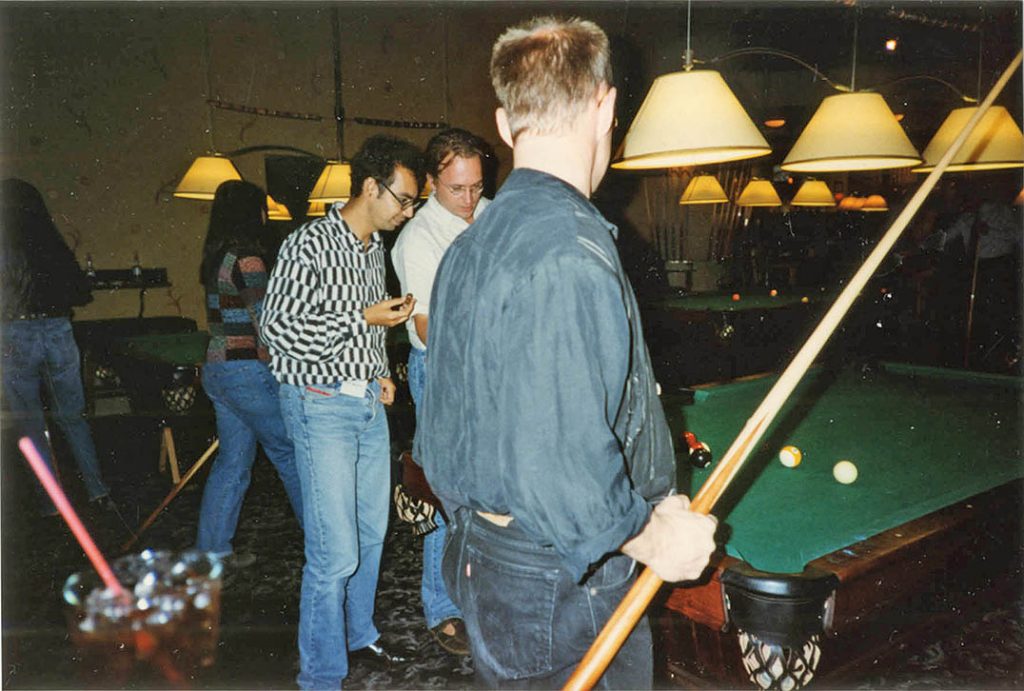
Typographers playing pool: Fred, Martin, Erik Spiekermann (back to the camera).
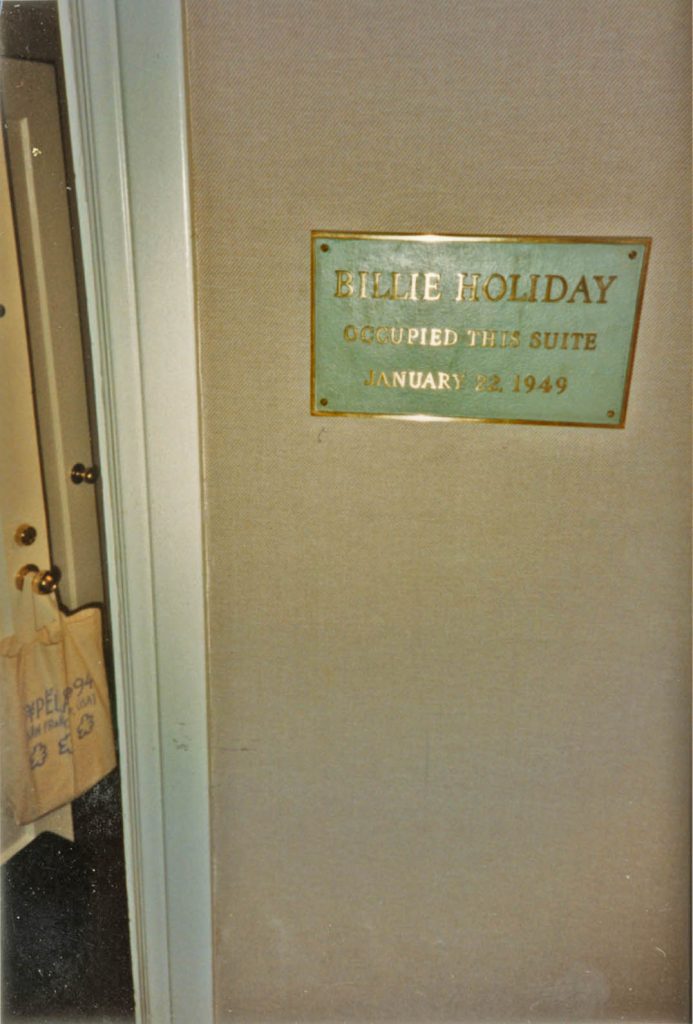
My room at the Hotel Mark Twain: on the door handle, an ATypI conference bag. And on the wall outside the room is a plaque that commemorates the event there of 22 January 1949, when Billie Holiday was arrested on a drugs charge.
————————————————————
Robin Kinross
————————————————————
Note
- This broad-brush account should be qualified in at least one important respect. Through the 1970s and 1980s, ATypI ran educational seminars alongside the main annual conferences. I have vivid memories of the seminar of July 1976 at Reading, where as a student helper I acted as assistant to the class run by André Gürtler and Christian Mengelt. Gerrit Noordzij, Berthold Wolpe, Nicolette Gray and Nicholas Biddulph were among the other teachers running seminars. But these were quite conventional master–student classes, and different from the anarchist and egalitarian spirit of the TypeLab. The last of the educational seminars took place at Budapest in 1993; as it finished, the very conventional type company meeting then started.